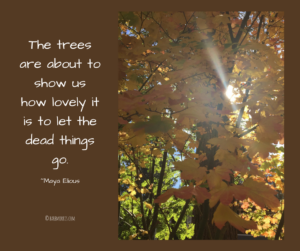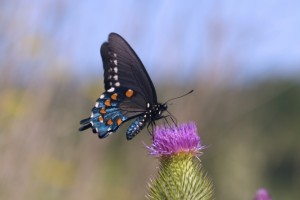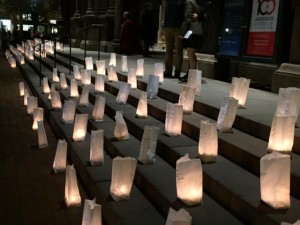 It’s fall in the Northern Hemisphere.
It’s fall in the Northern Hemisphere.
You know what that means, right?
Yup, pumpkin spiced everything.
And also blog post after blog post about letting go. Relaxing into the dark. Transformation. Transition. Change. About how we should be like trees and gracefully let the dead things fall away.
I’ve been guilty of it myself. (See header image.)
And yet. We’re not trees.
Please stop comparing yourself to a tree.
Humans and trees diverged very early in life’s evolutionary journey. Humans went on to evolve a large brain, with a cerebral cortex that knows it’s housed in a body that will die, and so the mind fears. A lot.
Maybe trees have fears, too, when fall comes and they feel their dead leaves drop away. Maybe they resist, too, just like we do.
I’ve been exploring ways to navigate transitions more kindly. My kids are self-sufficient adults, so I’m transitioning from active parenting to empty nester. I’m actively exploring nature-based spirituality, so I’m transitioning from Episcopalian to who knows what. I’m an entrepreneur, so I’m transitioning from fitting into a defined job to being in charge of my own work. My body continues to age, so I’m transitioning from young-ish woman to juicy crone.
Dying and rising and doing it all over again comes pre-installed in Earthlings. All Earthlings. Trees. Rocks. Water. Ravens. Humans. Change is not optional.
I’m finding that knowing who I am, having a sense of my core identity, the essence of “me,” is helpful. Knowing and staying in touch with my heart is one key to sane cycling and changing.
Just as a tree’s identity remains when it stands bare to the winter winds, I will still be “me” when outer identitifiers (mom, teacher, Christian, young …) fall away.
My heart identity lives in my body. It makes sense to me, then, that deeply knowing myself and living from my core starts with loving and paying attention to my body.
Who you are lives in your body. Deeply knowing yourself and living from your core starts with loving and paying attention to your body, in whatever form that takes for you. I suggest regular body scans, baths, movement, sweaty work, long walks – whatever feels delicious. “Let the soft animal of your body love what it loves.” (Mary Oliver)
Be warned, though. Your body is wild. Paying attention to your body means feeling your feelings. It means sitting with your pain and your joy. Giving yourself the gift of self-compassion.
We are not trees. For humans, with these brains that scream fears night and day, it helps so much to know and trust our hearts. To know that our bodies tell the truth, while our minds often don’t.
When we know who we are, the stuff we cling to that isn’t ours anymore, perhaps never was ours, can fall away like last year’s leaves.
(Would you like to explore navigating the changes and seasons of your life with kindness? I offer a free discovery call. Click here for details.)


